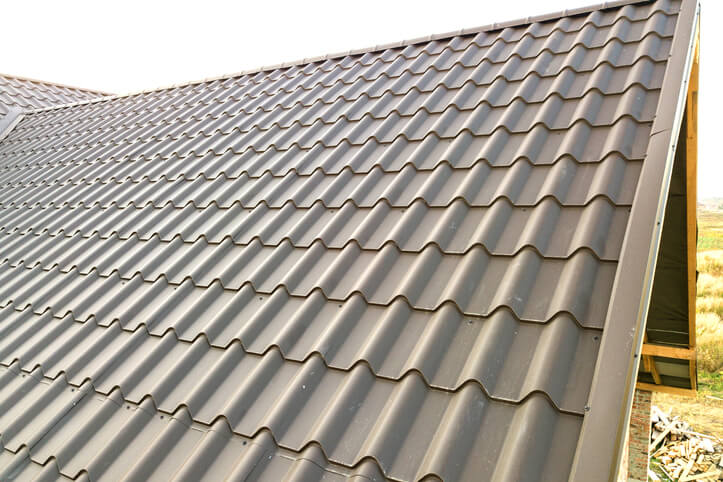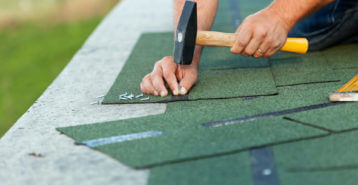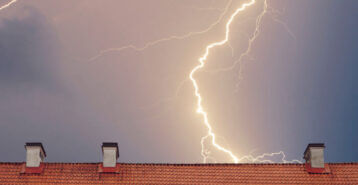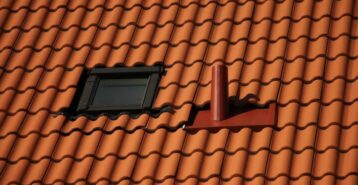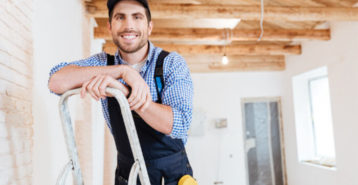Fire-Resistant Roofing: What You Should Know
When a wildfire comes roaring into a neighborhood, what determines whether a home is reduced to ashes versus a home that remains standing strong against the flames? The answer is often the fire-resistant roof. Though some might call them “fireproof,” that’s not entirely true — there really is no such thing as a fireproof roof, as no roofing material can fully withstand a wild inferno. However, there are some materials that can withstand quite a bit of flame, and that can be enough to save your home.
Let’s take a look at fire-resistant roofing, what fire ratings mean, what to expect from more complex installations, and more.
How to Find the Right Fire-Resistant Roofing
There are three classes of fire-resistant roofing: Class A, B, C, and unrated.
- Class A: These materials are recommended for those who live in areas prone to wildfires. These can include clay tiles, concrete, or asphalt-fiberglass composition shingles.
- Class B: These materials are tested to withstand moderate fire exposure. Pressure-treated wood shakes and shingles are among those in Class B.
- Class C: Untreated wood shakes, plywood, and typical shingles are considered Class C. They can withstand some mild fire exposure, such as embers blowing across the roof.
- Unrated: An unrated roof is extremely vulnerable to fire. The materials are not flame-retardant, such as wooden shingles.

But it’s important to remember that the rating of your roofing material doesn’t matter at all if you don’t have the proper assembly, including the roof coverings, insulation, and underlayment. For instance, a wind-driven ember that sneaks underneath the fire-resistant roofing material to catch on the underlayment can lead to a massive fire.
That’s why some materials have a “by assembly” Class A fire rating. That means that additional materials must be used between the roof sheathing and the material itself to be considered fire-resistant. These might include materials made of aluminum, recycled plastic, rubber, and fire-retardant wood.
What Is the Best Roofing for Fire Resistance?
Roofing materials undergo rigorous testing to determine their performance under flame and heat. The general test to determine a fire rating measures how quickly a fire spreads across a roof in 10 minutes. A roof that takes a long time to ignite — well over an hour — usually earns the Class A rating.
| Roofing Material | Fire Resistance | Why It’s Safe |
|---|---|---|
| Metal | Class A | Won’t ignite unless exposed to extreme heat. |
| Concrete | Class A | Fireproof, but gaps or cracks can be risky. |
| Clay | Class A | Fireproof but may allow embers through gaps. |
| Slate/Stone | Class A | Very fire-resistant, but prone to cracking from debris. |
| Fiberglass Asphalt | Class A | Fire-resistant due to fiberglass layer. |
| Synthetic Composite | Class A | Durable and heat-resistant; good for budget-conscious homeowners. |
| PVC | Class A | Self-extinguishing when flame is removed. |
| Recycled Rubber | Class A/C | Fire rating depends on the product and coatings used. |
| Asphalt Shingles | Class A/B/C | Fire rating varies by brand and coatings. |
| Pressure-Treated Wood | Class B | Slows ignition but still combustible. |
| Untreated Wood | Class C/Unrated | Highly flammable; not recommended in fire-prone areas. |
Metal
Fire Rating: Class A
Metal roofing, including aluminum, steel, and copper, is one of the safest options for fire resistance. It doesn’t ignite or burn and can withstand extreme heat, making it ideal for areas prone to wildfires. Even in intense fire conditions, metal roofs typically hold strong unless exposed to a direct, prolonged blaze.
Concrete
Fire Rating: Class A
Concrete tiles are naturally fireproof and won’t ignite under flame exposure. However, it’s important to ensure tiles are properly installed and free of cracks, as gaps could allow embers to reach the underlayment or roof deck.
Clay
Fire Rating: Class A
Like concrete, clay tiles are non-combustible. They provide excellent fire protection, though installation gaps between tiles could pose a risk if embers blow underneath. Proper installation is key for maximum safety.
Slate/Stone
Fire Rating: Class A
Slate and other stone roofing materials are extremely fire-resistant. While they can crack under impact from falling debris, the material itself will not burn, making it a dependable option in fire-prone zones.
Fiberglass Asphalt
Fire Rating: Class A
Asphalt shingles that contain a fiberglass base layer are much safer than outdated organic asphalt versions. The fiberglass adds fire resistance, allowing the shingles to withstand direct flame for a limited time.
Synthetic Composite
Fire Rating: Class A
Synthetic shingles made from rubber, plastic, or polymers often come with Class A fire ratings. They’re designed to resist high temperatures and can be a smart, budget-friendly alternative for fire-conscious homeowners.
PVC
Fire Rating: Class A
PVC roofing is notable for being self-extinguishing. It can catch fire if exposed directly, but it stops burning once the flame source is removed. This makes it a solid choice for flat roofs needing added fire protection.
Recycled Rubber
Fire Rating: Class A or Class C
Fire safety varies with rubber roofing. Some products are engineered with fire-resistant coatings for a Class A rating, while others — especially those made from untreated tires — may only meet Class C standards without added treatments.
Asphalt Shingles
Fire Rating: Class A, B, or C
Standard asphalt shingles are made with a petroleum base, making them inherently flammable. However, many manufacturers apply coatings that boost fire resistance. When choosing asphalt, always verify the specific fire rating.
Pressure-Treated Wood
Fire Rating: Class B
Treated wood shingles slow down ignition, offering more time before catching fire. While not completely fireproof, they provide a moderate level of resistance in lower-risk areas.
Untreated Wood
Fire Rating: Class C or Unrated
Untreated wood shingles or shakes are highly combustible and pose a serious fire risk. They’re not recommended for homes in wildfire-prone regions due to their low resistance to ignition.
Who Needs Fire-Resistant Roofing?
Those who live in areas prone to wildfires are an obvious answer to who needs fire-resistant roofing. In fact, some areas of California and other wildfire-prone states won’t approve any roofing material that isn’t a Class A.
But fire-resistant roofing isn’t just for homes in wildfire zones. You should consider a flame-resistant roof if your home is:
- Surrounded by vegetation, such as in wooded or brush-heavy areas
- Located close to neighboring homes, especially in tight urban layouts
- In a region where local building codes require Class A roofing materials
- Already equipped with fire-resistant siding and tempered glass windows
- Outfitted with a chimney or working fireplace
- Situated in a disaster-prone area where wind-driven embers or fires are possible
How to Find a Roofing Contractor
Remember that fire-resistant materials for your roof must be paired with the proper insulation, underlayment, and other underlying materials to be truly fire-safe. A good contractor who understands the nuances of these materials — and knows how easy it is for a tiny ember to find anything combustible — can help ensure that your home is as protected as possible.
Modernize connects you with local contractors in your area who bring their good reputation and impressive skills to work for you. We’ll help you find the right contractor so you can rest easy knowing your home is safe and secure.
Compare top-rated roofing pros in your area.
Read real homeowner reviews, explore qualifications, and view promotions. Modernize makes it easy to browse professionals and find one that will be perfect for your project.
